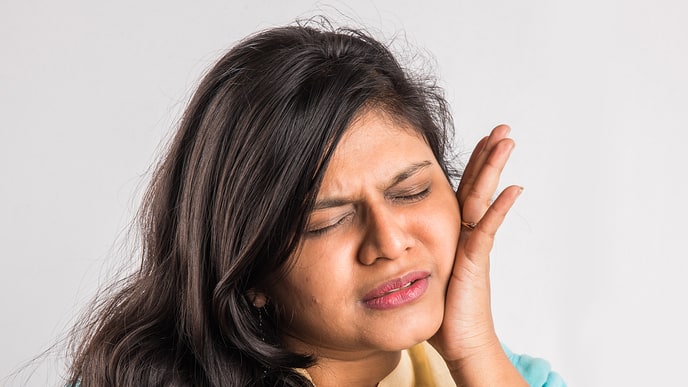What is Teething?
Teething is the process by which one or more teeth erupt out of the gums in babies and young children. Teeth development begins as tooth buds form in the gums when the baby is in the womb. Following birth, teeth push themselves out of the gums during the teething period. Understanding the typical range of teething at babies' ages helps parents be prepared to manage the baby’s discomforts during this period.
The Indian Dental Association (IDA) states that teething age can vary from child to child. In some cases, the first teeth appear as early as three months of age; in others, it may take up to a year. During a lifetime, human beings develop two sets of teeth. They are:
Milk teeth: The first set of teeth that appear in infants are also called primary, deciduous, or baby teeth. They are temporary and eventually fall out.
Permanent teeth: The secondary or permanent teeth erupt as the milk teeth fall out.
At What Age Do Babies Start Teething?
A baby's first tooth can typically appear anytime, from six months old to the first year. The baby teething age usually extends up to thirty-three months. At the age of three, the baby is likely to have a full set of twenty milk teeth, ten each in the upper and lower jaws. Each jaw will have four front teeth (incisors), two canines, and two of the first and second molars.
The IDA’s teething chart shows a detailed timeline for milk teeth eruptions. On each jaw, two central incisors appear between the sixth and twelfth months, and two lateral incisors erupt between the ninth and sixteenth months. Four canine teeth, two on either jaw, erupt between the sixteenth and twenty-third months. The back teeth, or molars, four each on either jaw, are usually the last ones to appear between the thirteenth and thirty-third months.
Good oral hygiene is vital for retaining your little one’s healthy smile. Regular dental visits and checkups after tooth eruptions are essential. As your baby starts consuming solid foods, adopting good dental care habits is crucial, and they include the following:
Before the first teeth erupt, it is ideal to clean the baby’s gums with a piece of clean, soft gauze dipped in water after feeding and at bedtime.
As the first teeth erupt, you may start cleaning the baby's teeth with a soft-bristled toothbrush and water after every meal and at bedtime. For instance, consider using the Colgate Toothbrush for Kids. It is designed for infants aged 0 to 2 years who are developing milk teeth. It has a small head that provides easy access to the baby’s mouth and extra-soft bristles that gently clean the soft teeth and gums.
Flossing is ideal once your baby develops teeth that are touching one another.
Common Teething Symptoms
When a tooth starts to break through the gumline, it naturally causes mild discomfort for your little one. The different signs of baby teething help you identify if your baby is getting the first baby teeth out. Some of the common symptoms of teething include:
Tender gums
Drooling
Irritability or fussiness
Trouble sleeping
Gnawing and biting on toys
All of these signs are completely natural, and some of them will occur throughout the teething process. Every new tooth will take from a few days to a few weeks to completely erupt. Teething may cause mild changes in the baby’s body temperature. However, if symptoms like fever or diarrhoea are noticed, they are not caused by teething and require you to consult a paediatrician.
How to Soothe a Teething Baby?
While baby teeth age is different among babies, there is one thing they all have in common. Teething often leads to some discomfort, and babies need help to ease their teething pain. As a parent, there are various things you can do to make the baby teething process more comfortable and less painful. They include:
Rub the gums: Gently rub the baby’s gums with a clean, wet, cool washcloth. Alternatively, you may use a clean finger to rub the gums if the teeth are almost surfacing.
Cold objects or teething rings: You may give your baby a cold rubber teething ring to chew on to relieve the discomfort. It is ideal to avoid objects that break easily, such as plastic teethers or necklaces, to avoid any accidental choking hazards and strangulation.
Watch the baby’s diet: It is ideal to feed your baby cool and soft foods to soothe the discomfort and avoid irritating the gums.
Use a bottle of cold water: You may provide your baby with a bottle filled with cold water to soothe the pain and discomfort. Ideally, avoid filling the bottle with juice or milk to reduce the chances of tooth decay.
Get medical help: If the symptoms do not go away despite following the above tips, it is ideal to consult a paediatric dentist for medical advice. Though various teething gels and over-the-counter pain relievers are available, it is essential to consult a healthcare professional before using any of them for your baby.
Teething And Baby's Health
Teething is an important milestone for every baby. The eruption of primary teeth at the right time helps with the little one’s nutrition, speech, and the development of permanent teeth. While mild discomfort is a common feature of typical baby teething age, symptoms such as diarrhoea or high fever may indicate something else and need medical attention.
Oral health is crucial for the baby’s overall health. By age two, you may teach the baby to spit and use a pea-sized amount of fluoride toothpaste with a soft kids’ toothbrush to brush your child’s teeth. For example, you may try the Colgate Toothpaste for Kids (0–2 years) with a 50% less abrasive formula than adult toothpaste. It contains natural flavours and ingredients, gently cleans the milk teeth without harming the enamel, and fights cavities and plaque.
Teething is a natural process all babies go through, though its timeline can vary. The typical baby teething age ranges from six months up to the age of three. By understanding the common teething symptoms, parents can be well-equipped to make their babies comfortable during the teething period. Adopting good oral hygiene practices early on is crucial for your little one’s healthy smile.
Frequently Asked Questions
1. What are the first signs of baby teething?
Teething symptoms can differ among babies. Typical first signs of teething include increased drooling, irritability, tender or sore gums, and a tendency to gnaw or chew on objects. Some babies may show swollen or tender gums, sleeplessness at night, and a slight rise in body temperature.
2. What age is too late for teething?
Most babies start teething between six and twelve months. In some babies, it may begin as early as three months or as late as a year. If the baby hasn't shown any signs of teething by eighteen months, it is ideal to consult a paediatrician or paediatric dentist to rule out any underlying reasons.
3. What causes babies to get teeth early?
Even though babies usually start teething around the sixth month, it is natural if your baby starts teething early. In rare cases, a baby may even be born with teeth. Early baby teething is usually harmless and can occur for various reasons, including genetic factors.
4. How to speed up teething in babies?
Teething age can differ among babies, and it is natural if a baby’s first teeth take up to twelve months to erupt. However, you may help your teething baby ease the discomforts and teeth faster by massaging the gums with a clean finger, providing cold teething rings to bite on, and ensuring proper nutrition.
This article is intended to promote understanding of and knowledge about general oral health topics. It is not intended to be a substitute for professional advice, diagnosis or treatment. Always seek the advice of your dentist or other qualified healthcare provider with any questions you may have regarding a medical condition or treatment.
ORAL HEALTH QUIZ
What's behind your smile?
Take our Oral Health assessment to get the most from your oral care routine
ORAL HEALTH QUIZ
What's behind your smile?
Take our Oral Health assessment to get the most from your oral care routine













